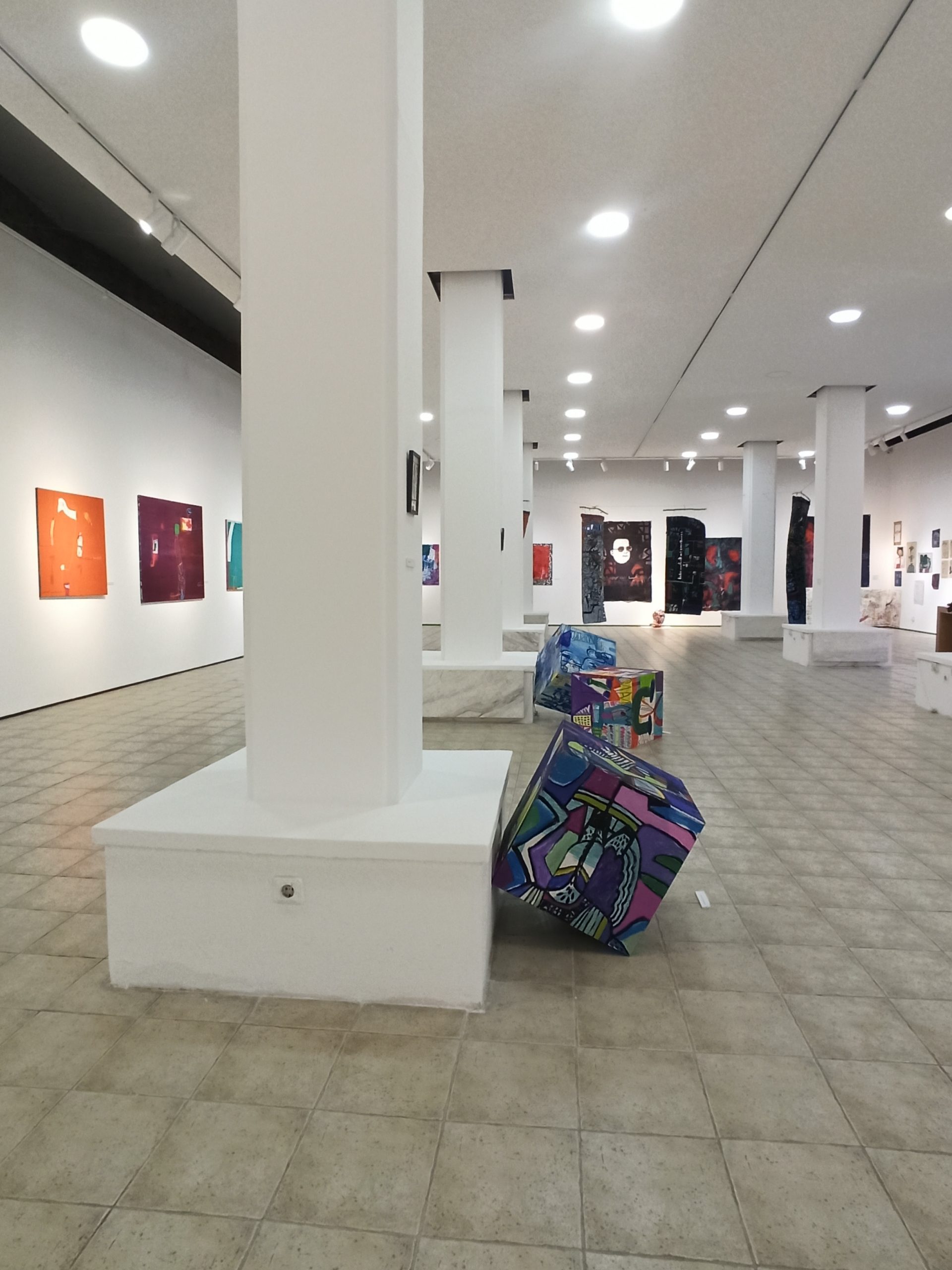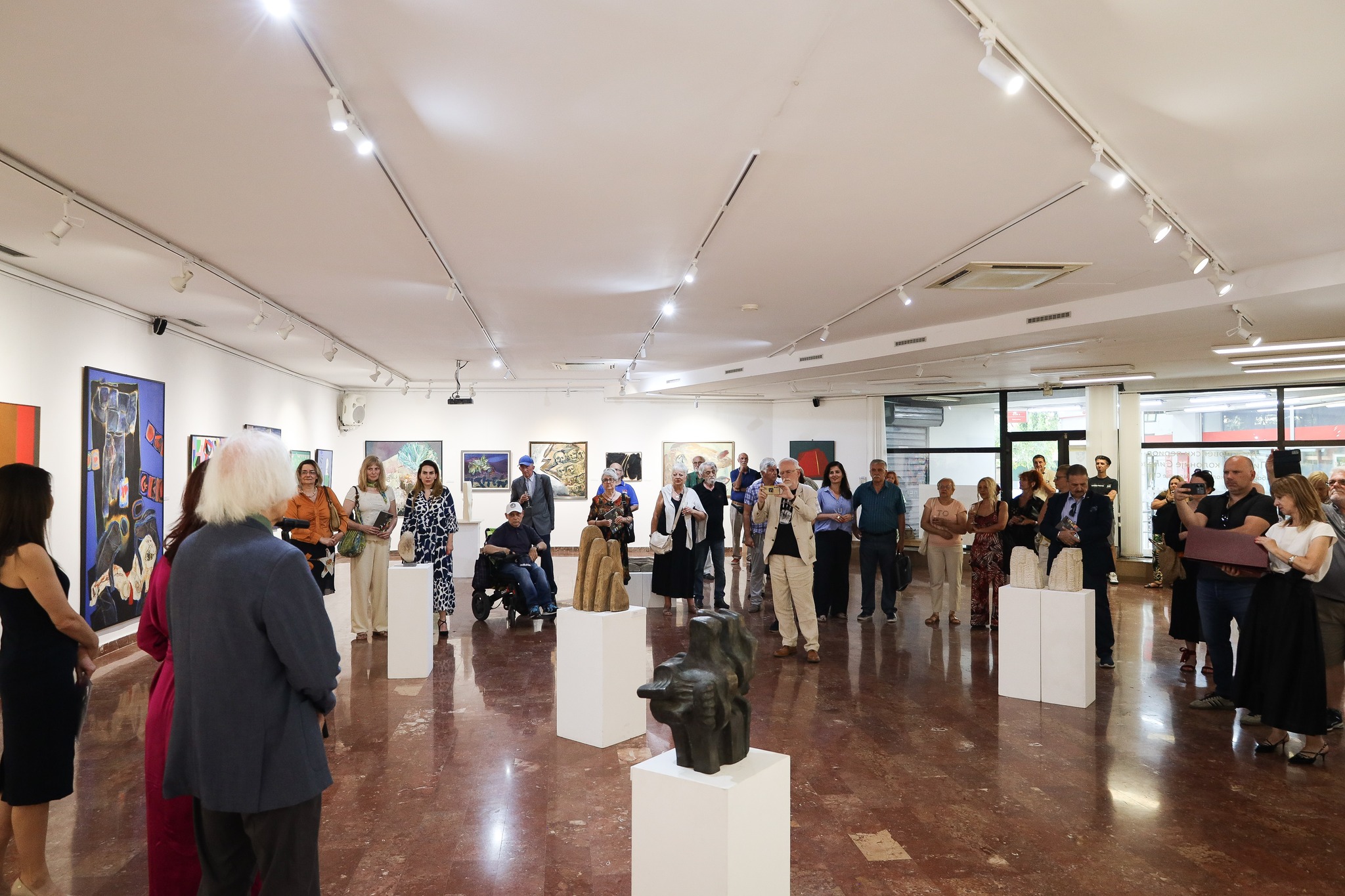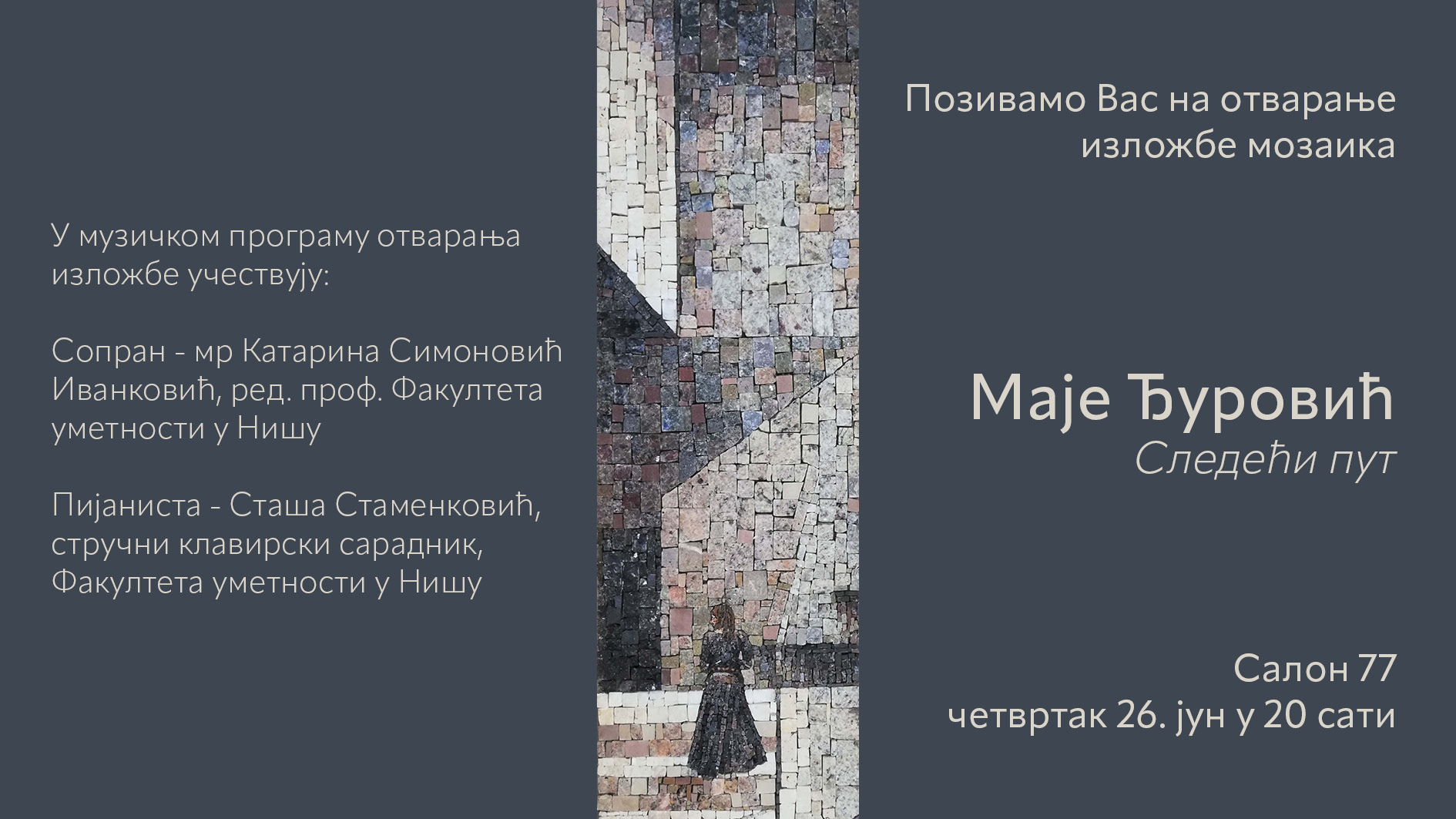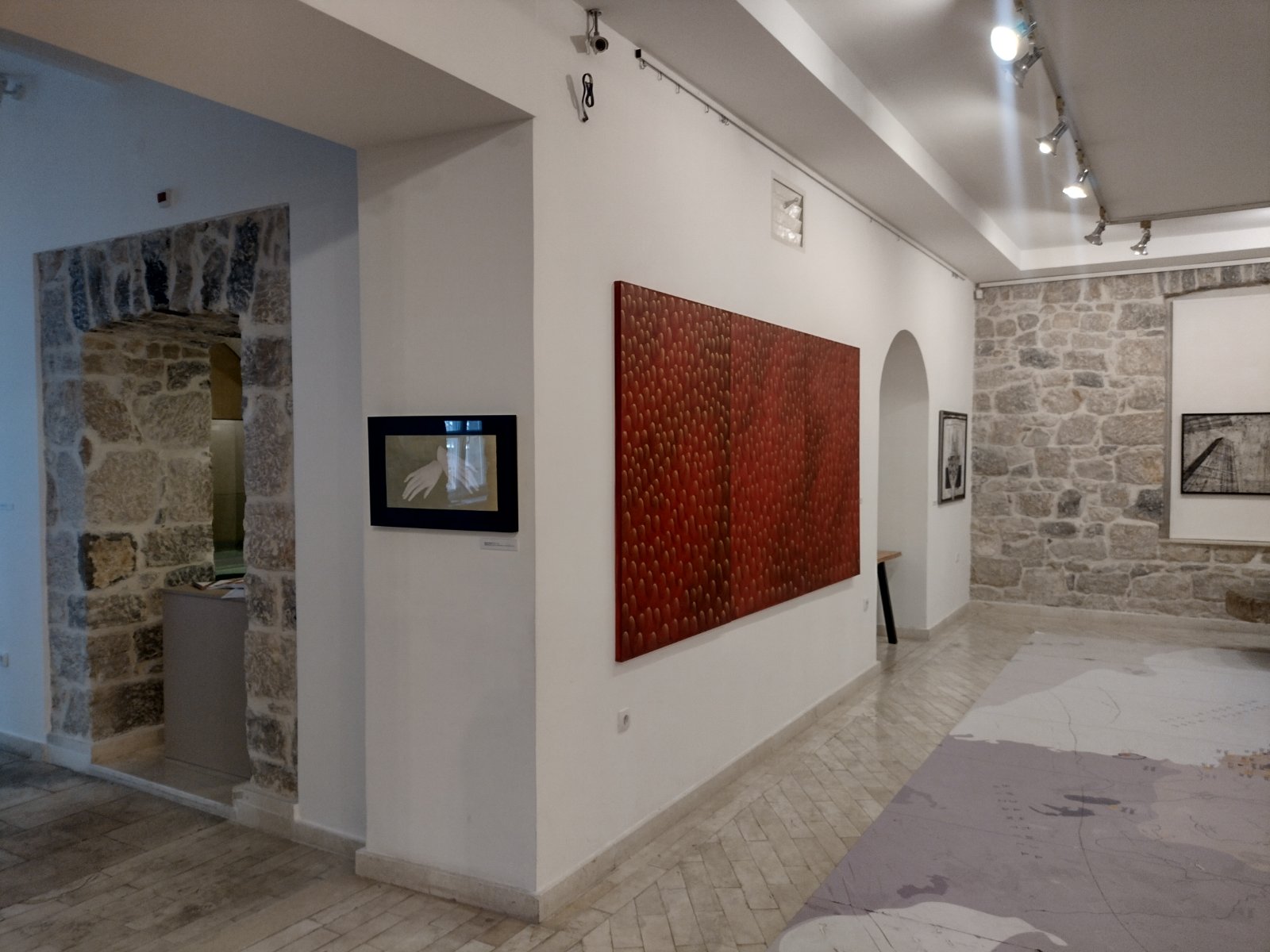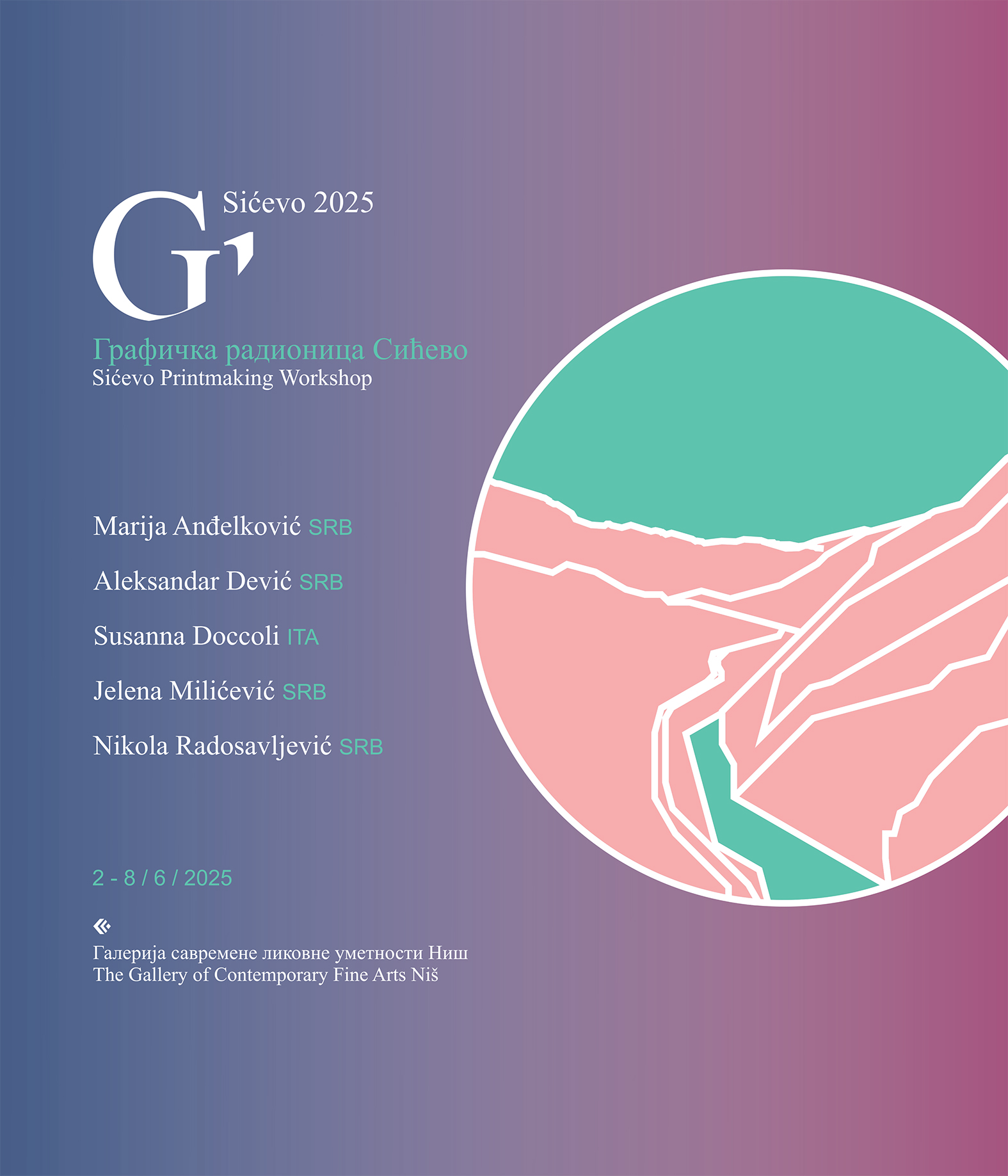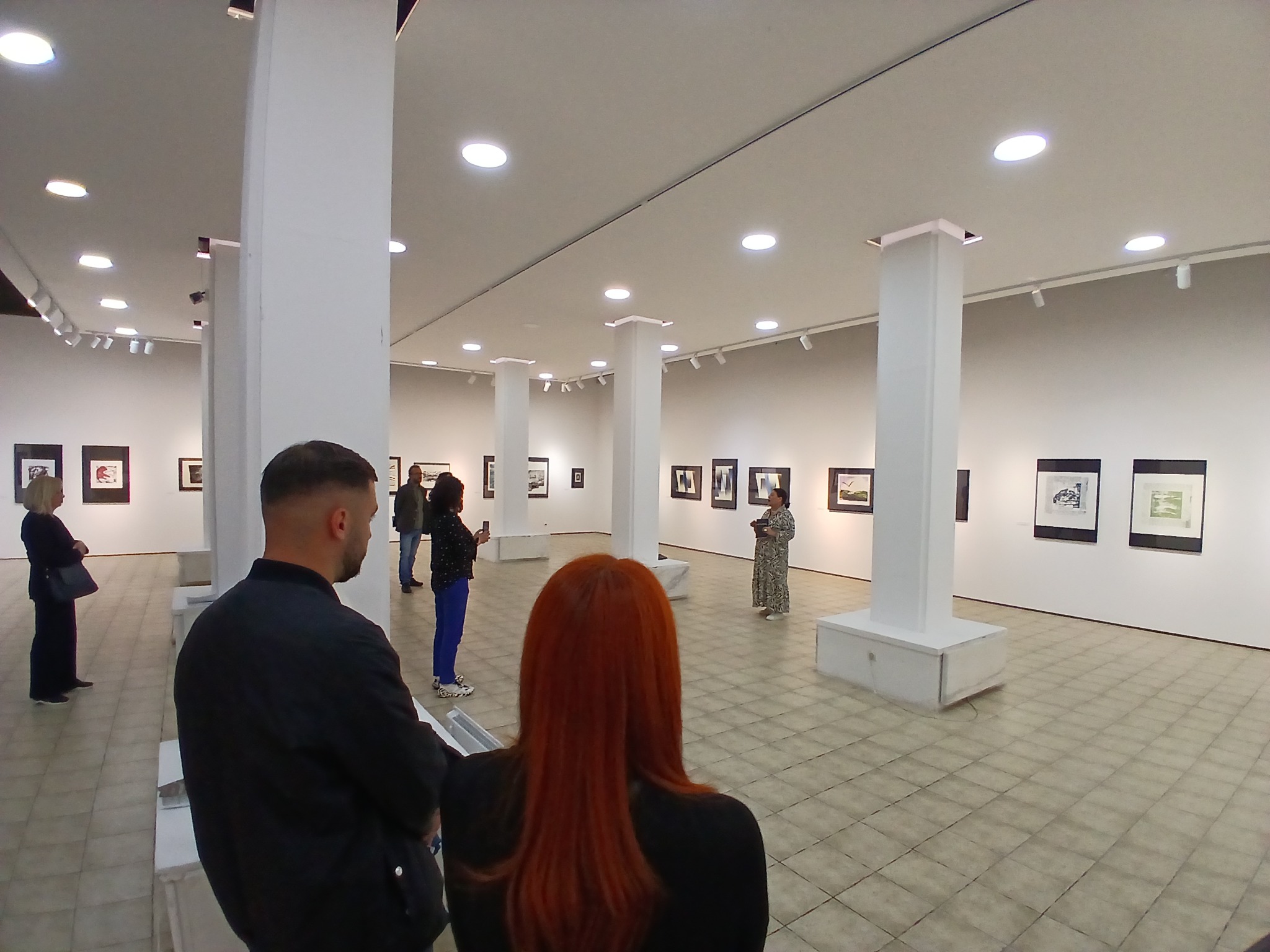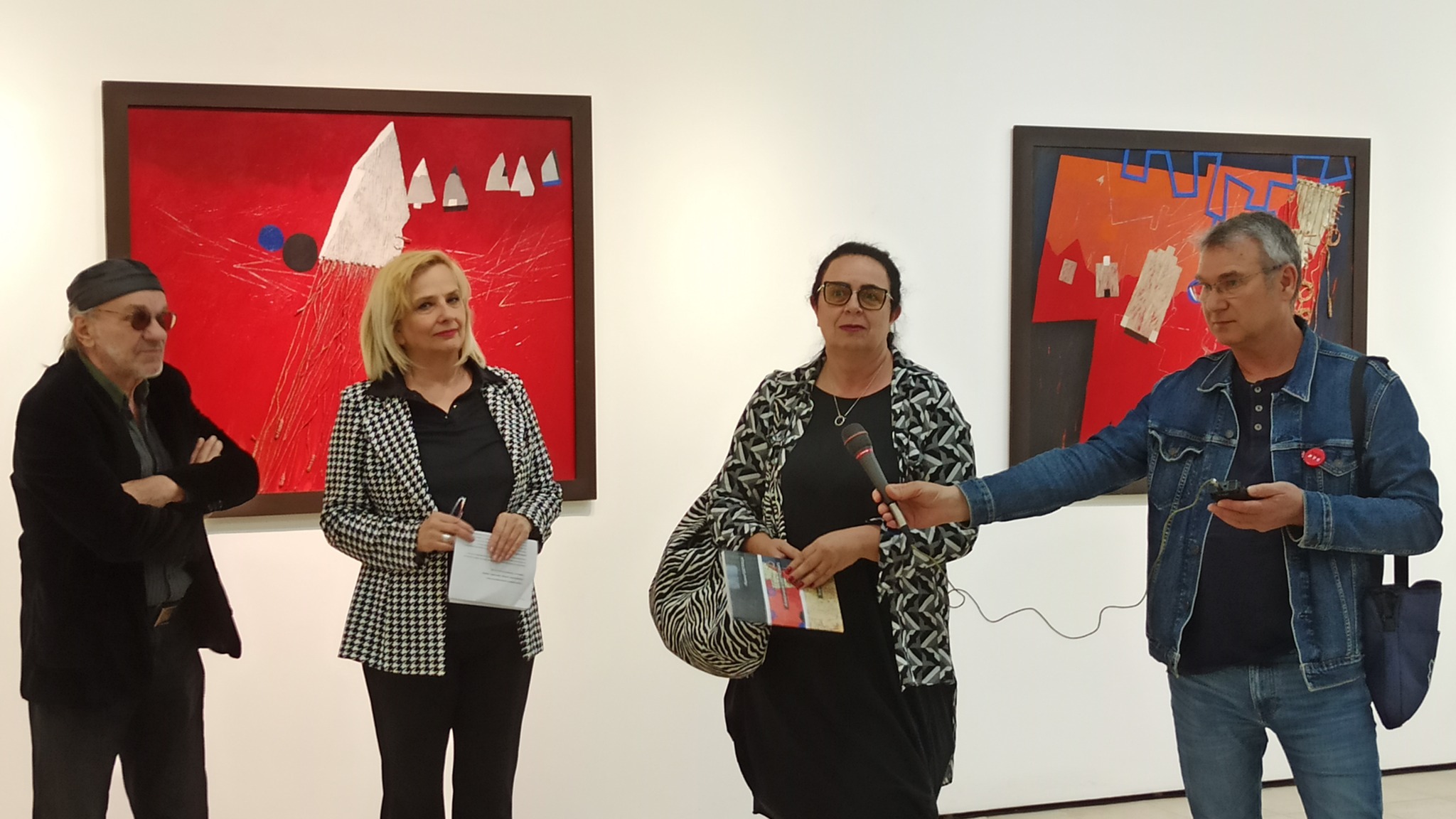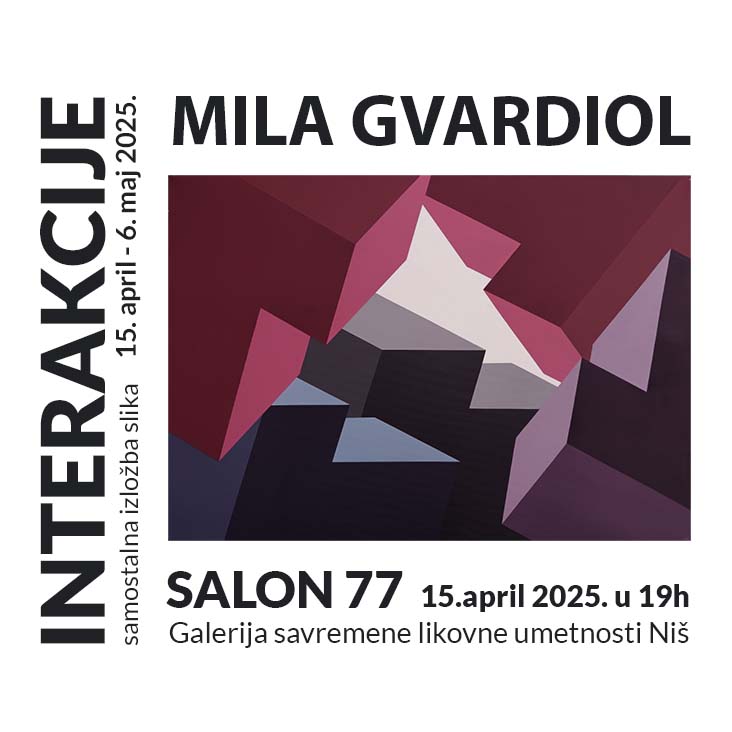АКТУЕЛНО
Double naked
Joškin Šiljan
Double Nude
paintings and drawings
Fortress Pavilion
Joškin Šiljan is exhibiting at the Gallery of Contemporary Art Niš from June 19 to July 13. The exhibition of his paintings and drawings, entitled "Double Nude", will be officially opened on Thursday at 8 p.m., at the Fortress Pavilion.
The exhibition in Niš includes works from several different cycles, and the title is due to the most recent one.
“Through his creative work, Joškin Šiljan creates new worlds, while simultaneously expressing the philosophical nature of his thoughts. His painting constantly explores pure art, which expresses freedom and spontaneity both through the iconography itself and authentic visual language, as well as through reflections and the artist’s understanding of the world, which is as such light and simple, unburdeningly fresh.”, observes art historian Ana Kršljanin, curator of the ŠTAB gallery. She sensitively concludes that the artist “swims in the limitlessness of themes, movements and beings that, with witty and long titles, give the viewer an impulse that he needs to feel and convey, allowing him to be the one who completes the picture and the story.”.
Joškin Šiljan (Nebojša Stojković, 1953, Pirot) belongs to the generation of artists who emerged on the art scene in the 1990s. He is one of the most famous and active authors on the regional art scene, and his exhibitions in world museums and galleries make him internationally visible and recognized. He is a participant in a large number of art colonies and residency programs in the country and abroad. His works are in significant museum, company and private collections around the world. He has won several significant awards, including: the Golden Palette of ULUS (2006), the Grand Prize at the 14th Biennial of Naive and Marginal Art (2009), the Main Prize for Painting on Paper OSTEN (2016), and the Golden OSTEN for Drawing (2018).
He lives and works in Grdelica.
The exhibition of his works can be visited by the public until July 13, in the Paviljpn in Tvrđava.
EXHIBITION YUGOSLAV PERIOD OF THE ART COLONY SIĆEVO - SELECTION OF WORKS FROM THE GSLU NIS FUND
This year marks the 120th anniversary of the founding of the First Yugoslav Art
Ethnic Colony. The founder of Serbian modernism, the famous painter Nadežda Petrović, and her colleagues from her Munich school days, gathered around the idea of cultural unification of the South Slavic peoples, by coming to a village in southern Serbia and working in the open air, they left a significant legacy for this part of the country. The idea of an artist’s stay in Sićevo every summer did not take root, so it was renewed under the name of the Sićevo Art Colony six decades later and has been continuously held since then to this day. 545 domestic and foreign authors of different generations and styles participated in the work of this now public city event, who enriched the Gallery’s collection with 912 paintings, graphics, new media and sculptures. These works represent a lasting value and are a significant cultural heritage of the city.
The anniversary is an opportunity to gain insight into the rich, carefully formed collection from the 1970s to the present day, to point out the significance of the artistic undertaking of that time and, in the context of the wider cultural space, tradition, social and political circumstances, to examine the influence on contemporary artistic thinking, understandings of fine arts and echoes in creativity. The concept of the exhibition in gallery 73 reflects the idea of unity and Yugoslavism through the selection of paintings and sculptures created during the existence of Yugoslavia and the participation of authors from the former republics. The artists enjoyed the freedom and work under the open sky, so they were encouraged by the surroundings, the Sićevačka landscape, the beauty of the gorge, the rocks, and the sumptuous palette of colors, general impressions and visual sensations, each in their own unique way, applying individual artistic expression, they woven into their works (Milenko Šerban, Mihajlo Petrov, Stojan Trumić, Čedomir Krstić, Boža Ilić, Stojko Stojković, Miroslav Anđelković, Perica Donkov, Velizar Krstić, Miodrag Protić, Momčilo Antonović, Kosta Bradić, Rada Selaković). Some authors used the rich cultural and historical heritage of this region as a starting point for research and expression of personal reflections (Ivan Tabaković, Bata Mihailović), the dialogue between nature and historical and artistic heritage (Mladen Srbinović, Čedomir Vasić, Tomaž Kržišnik), or by questioning their inner worlds, they introduced a dose of mysticism into idyllic landscapes (Bojan Bem, Ređep Feri), and imaginatively, almost uninhibitedly, indulged in the world of fairy tales and mythology (Radomir Reljić). For some, Sićevo was an opportunity to express their own preoccupation and critical attitude towards social and socio-political circumstances in a new environment, without communicating the impressions of their immediate surroundings (Mića Popović, Zoran Pavlović), a rational and analytical approach in the spirit of new geometry (Stojan Ćelić, Bora Iljovski, Borko Lazeski) or expressive representations of the experienced (Velizar Krstić, Petar Mazev).
The exhibition presents the sculptor’s works created during the 1970s and 1980s. Forming mainly in traditional materials, within the framework of figuration, they found their expression in the classical anatomical form (Aleksandar Šakić, Viljem Jakopin) or archetypal form (Nikola Antov), skillfully combining forms within the framework of geometric stylization (Momčilo Krković) or suggestively breaking down the classical view of sculpture while experimenting with more contemporary materials (Olga Milić) to the depiction of reduced associative forms (Ivan Felker, Dušan Donkov, Nikola Njirić). By presenting paintings and sculptures by prominent protagonists of the Yugoslav art scene, the impact of the unique cultural space and the importance that the Sićevačka colony, which originated on the achievements of the First Yugoslav Art Colony, had, was to some extent perceived. Its noble mission and value oblige us to preserve tradition, carefully select participants, adequately care for and preserve exhibits, and create opportunities for their presentation on a larger scale.
June 19 – July 1, 2025
Maja Đurović "Next Time"
Opening of the exhibition on June 26th at 8pm
Exhibition of mosaics by Maja Đurović: “Next time”
Maja Đurović (1977) graduated from the Faculty of Fine Arts in Belgrade, Department of Graphics, in the class of Professor Biljana Vuković. She has been a member of the Association of Fine Artists of Serbia since 2009. She has exhibited at seven solo and over seventy group exhibitions in the country and abroad. She has won several awards for mosaic: FLU Award for Mosaic at the Exhibition of Awarded Students 2005/2006; Plaque for Artistic Contribution to Contemporary Mosaic by the group of fine artists Ametist in Belgrade 2007; Honorable mention at the exhibition of small-format mosaics by the “Ametist” art group in Belgrade in 2011 and an award for exceptional artistic work at the exhibition of the 5th Biennial of Mosaics, organized by the Student Cultural Center New Belgrade in 2012.
She received a commendation for graphics at the 25th October Art Salon in Kovin in 2007; Special recognition for merit at Art Fest & Doral, Miami, Florida, USA, 2012, as well as Plaques from the “Heritage of Metropolitan Pitirim” Fund for the contribution and progress of Serbian art in the Slavic world for participation in the exhibition “1150 Years of Slavic Literacy and Culture”, Moscow, 2013.
For the Tourist Organization of Serbia, she realized replicas: the Medusa mosaic from the ancient settlement of Mediana near Niš and the Venator mosaic from the Felix Romuliana palace near Gamzigrad, 2013. Maja Đurović’s research focuses on the analysis of the inner life of an individual, that is, the state of his or her own being in relation to the environment. Through portrait motifs and human figures, she visualizes the character of the portrayed, emphasizing their individual characteristics. Skillfully handling the technique of mosaics made in natural stone, Maja Đurović presents in a special way her story about passivity, alienation, and apathy in the time and society that surrounds us. The atmosphere is almost elegiac, stopped in a moment that indicates a deep thoughtfulness about one's own existence. All the exhibited works deal with the fate of an ordinary person through visions of lonely, depressed characters who move through the silence of space, wandering aimlessly.
The artistic program of the opening of the exhibition includes:
soprano: Katarina Simonović Ivanković, full professor at the Faculty of Arts in Niš
pianist: Staša Stamenković, professional piano associate, Faculty of Arts in Niš
Exhibition of Fine Artists of Niš - selection of works from the collection of the Academy of Fine Arts of Niš
Exhibition of Fine Artists of Niš - a selection of works from the collection of the Gallery of Contemporary Fine Arts Niš
Herzegovina Museum in Trebinje, 4 - 24 June 2025
On Wednesday, 4 June, the Museum of Herzegovina in Trebinje opened the exhibition of Fine Artists of Niš - a selection of works from the collection of the Gallery of Contemporary Fine Arts Niš, authored by Emilija Bilić, senior curator. By presenting the works of Niš artists in Trebinje, the two cultural institutions are starting an inter-institutional cooperation, and it will also be an opportunity for the public of this region, based on the selected works, to get acquainted with the creativity, individual development path of the artists and gain insight into the art scene of the city.
The focus on this topic was motivated by the intention to highlight the valuable contribution of women in the field of visual arts, but also by the personality, work and social engagement of Nadežda Petrović, a famous painter who 120 years ago founded the First Yugoslav Art Colony in the village of Sićevo, not far from Niš, the forerunner of today's Sićevo Art Colony. It is precisely thanks to the Sićevo Colony, the Graphic Workshop, purchases and gifts from solo and collective exhibitions that the GSLU fund represents one hundred works by forty authors of different generations, stylistic orientations and artistic practices, which are a significant cultural heritage of the city.
Building their professional identity, women artists have mostly remained faithful to the medium of painting, drawing and graphics, with only a few sculptures being represented, with a noticeable lack of interest in research in the field of new media and photography. Heterogeneous in visual expression, approaches and reflections, within a given chronological framework, the works testify to movements in the art of southeastern Serbia, the openness of the environment to new phenomena and contemporary aspirations, and provide the possibility of comparison in a local and broader context.
With the narratives and poetics represented, the exhibition depicts diversity and presents artists as active actors on the scene, who, stimulated by intense events and changes in fine arts, with the undoubted influence of heritage and tradition, while remaining consistent with their style and vocabulary, followed prevailing tendencies, gladly applied new knowledge, researched and experimented with techniques and materials. Compared to the number of male painters, graphic artists, and sculptors, there is a small number of academically educated female artists who have created in this environment, but taking into account the multiple roles of women in society and life in general, along with the need for self-realization, their contribution to the cultural sphere is valuable.
It is realistic to expect that female artists from Niš will soon, with the opportunities offered by modern technologies and scientific achievements in the field of art, along with communication and exchange with other cultural spaces, step into the world of new media, and that subsequent analyses and presentations will also include such types of research.
It is encouraging that interest in fine arts as a future calling is increasingly present, and that this environment every year gives birth to new generations of young female artists, whose works and engagement will one day, as part of the GSLU collection, encouraged by this, be the subject of new reflections and studies.
The exhibition will be open to the public until June 24th.
GRAPHIC WORKSHOP SIĆEVO 2025.
The participants of this year's Graphic Workshop 2025 are:
Susanna Doccioli / Italy/, Nikola Radosavljević /Užice/, Marija Anđelković /Belgrade/, Jelena Milićević /Belgrade/ and Aleksandar Dević /Niš/.
In the jubilee year when the Gallery of Contemporary Fine Arts Niš marks 120 years since the founding of the First Yugoslav Colony Sićevo, the International Graphic Workshop Sićevo, as a newly founded colony, celebrates 20 years of its existence. By popularizing the graphic medium, this type of residency brings together significant names from both the Serbian and international art scenes, but also follows the development of young authors from the graphic world. The collection of graphic sheets in the Fund of the Gallery of Contemporary Fine Arts Niš now numbers over 200 graphic sheets, of various techniques and styles created only thanks to the Graphic Workshop.
From June 2 to 8, 2025, graphic artists will be staying in Sićevo in the Colony building. In addition to working in the workshop, exchanging personal experiences in the field of graphic techniques, and socializing, the artists will spend one day in the city of Niš and visiting cultural and historical landmarks and getting to know the tradition and culture of our environment.
Susanna Doccioli / Italy /, Susanna Doccioli was born and raised in Rome. To further her education in the field of graphics and graphic and visual communication at the prestigious I.S.I.A. Institute for Graphic Design, she moved to Urbino. While staying in Urbino, she joined the International Center for Graphic Arts - KAUS. Later, she continued her education in Berlin and Rome.2018. In 2011, she founded the Stamperia Ripa 69 Association with other graphic artists, of which she is the president and collaborates with various institutions and workshops in organizing exhibitions and workshops in teaching woodcut techniques and basic engraving techniques. Her works are in many private and public collections. In addition to her artistic engagement, she is also engaged in pedagogical work, but also works as an illustrator and designer for numerous well-known publishing houses in Italy.
Nikola Radosavljević /Užice/. He was born in Užice in 1991. He completed his undergraduate and master's studies at the Faculty of Applied Arts in Belgrade. He received his doctorate in the field of new media graphic practices at the same faculty in 2020. He completed his second master's studies at the Faculty of Fine Arts in Belgrade, Department of Graphics, in 2022. He has received several awards and recognitions, including the Graphic Arts Triennial Award, Ural, Russia, the Grand Seal of the Graphic Arts Collective Gallery and the Golden Needle of ULUS, the Grand Prize of the International Graphic Arts Triennial in Krakow, Poland. He has participated in a large number of collective exhibitions in the country and abroad, as well as in many residency programs. So far, he has organized 38 solo exhibitions.
Marija Anđelković /Belgrade/, Serbian graphic artist born in 1988 in Belgrade. She completed her undergraduate and master's studies in Belgrade at the Department of Graphic Arts, Faculty of Fine Arts, in the class of Professor Dragan Momirov. As part of a student exchange, she spent one semester in Krakow. She has been a member of ULUS since 2013. So far, she has organized eight solo exhibitions. She has exhibited at numerous collective exhibitions in the country and abroad. She has been awarded several times for her work. She has participated in several domestic and international art projects and graphic workshops. She was invited by the International Center for Graphic Arts in Ljubljana to lead a master class in lithography in 2024. Since 2018, she has been employed at the Center for Graphic Arts and Visual Research at the Faculty of Fine Arts in Belgrade, as a printmaker.
Jelena Milićević /1992/ is a visual artist whose work includes graphics, illustration, and neon installations. She graduated and received her master's degree from the Faculty of Fine Arts in Belgrade, where she completed her master's studies in the graphics department in 2016. After her studies, she worked as a lithographer at the Center for Graphic Arts and Visual Research "Akademija". She developed her artistic experience and skills through collaboration with artists from the region, Europe, and South America, as well as through participation in numerous workshops and exchanges. She has exhibited in numerous collective exhibitions and has organized eleven solo exhibitions, of which we highlight the exhibition in London in collaboration with Faww Gallery. Her works are in private and public collections in Serbia and Great Britain. In addition to graphics, she also illustrates books of newspaper articles. She lives and works in Belgrade.
Aleksadnar Dević /Belgrade/ born in 1954. He graduated from the Faculty of Applied Arts in Belgrade, where he also completed postgraduate studies in the Department of Graphics. He is a member of ULUS. He has participated in numerous collective exhibitions in the country and abroad. In recent years, he has been intensively involved in computer graphics. For a short time, he worked as a professor of computer graphics and graphic design at the Secondary Art School in Niš, as well as at the Faculty of Arts in the subjects of Graphic Communication and Prosthodontic Graphics. From 2000 to 2004, he was the director of the Gallery of Contemporary Fine Arts in Niš. He has received numerous awards for his work. He has organized over ten solo exhibitions so far.
"Word and/or Image, Ethics and/or Aesthetics" by Irena Vuković
"Word and (or) Image, Ethics and (l) Aesthetics" by Irena Vuković - an artist from Podgorica. The exhibition consists of digital drawings printed on canvas, realized in the last five years.
Irena Vuković was born in 1975 in Titograd. She graduated from the Department of Graphic Design at the Faculty of Fine Arts in Cetinje, in the class of Professor Mile Grozdanić. She received her master's degree in 2020 from the same faculty with the thesis "Graphic Design of the Edition or the Artistic Autonomy of the Book". Since 2014, she has been working as a professor at the Secondary Art School "Petar Lubarda" in Cetinje. She has exhibited solo in Podgorica, Tivat, Herceg Novi, Pančevo, Vranje, Belgrade, Bijelo Polje. She has participated in numerous collective exhibitions, art and creative workshops in the country and abroad. She has been a member of the Association of Fine Artists of Montenegro since 2005. She won the "Good Design" award at the Novi Sad Book Salon (2008) for the graphic design of the "Nobel Prize" edition.
With an interdisciplinary approach, combining the experience of graphic design with painting and drawing, and applying modern technology in its implementation, Irena Vuković develops an indigenous opus based on original visual art and visuality that synthesizes text and image.
Personally, active reflection on contemporary social relations and circumstances opens up a wide range of psychological, ethical, and ultimately existential themes for Irena Vuković, which the artist interprets with a pronounced dose of humor, often with a bitter undertone. Supporting the form of comics, Irena mainly defines scenes in the form of dialogues between figures, often presented on a geometric background that is reminiscent of pixels of electronic images or graphics of old video games. Her figures are expressively caricatured in character with intense yet harmonious colors, and the texts they "pronounce" are either witty wordplay or verses whose form refers to traditional folk literature, while the content reflects contemporary vocabulary and situations.
Irena Vuković is the author of a special mental and emotional code and clear perceptions of the circumstances of her own time. Her works, as inspired visual testimonies of the "new normality" we live in and current models of behavior, provoke reflection on the perspective of living in conditions of shaken humanistic principles.
The exhibition will run until June 23.
GRAPHIC WORKSHOP ''SIĆEVO 2022-2024''
EXHIBITION OF GRAPHICS CREATED IN THE GRAPHIC WORKSHOP IN SIĆEVO 2022-2024, PAVILION IN THE FORTRESS
May 27 - June 22, 2025
For several years now, the Gallery of Contemporary Fine Arts Niš, as a highly professional institution in Serbia, has been organizing the Graphic Workshop in the beautiful village of Sićevo near Niš.
Initiatives to equip the graphic workshop began in 2003 at the suggestion of Slobodan Radojković, then a master of graphics employed at the Gallery. One of the rooms within the building of the Art Colony "Sićevo" was converted into a graphic workshop, when a gravure printing press was purchased.
In 2005, the Gallery of Contemporary Art celebrated the centenary of the first gathering of artists in the Art Colony in Sićevo. Soon after, all the basic funds and necessary materials for work were secured, thus creating the conditions for the first gathering of four artists in September 2006. There are multiple reasons why the Gallery decided to establish a graphic workshop. First of all, it was noted that there were only two workshops of a similar nature in Serbia: in Smederevo (Graphic Studio of the Cultural Center) and Belgrade (Centre for Graphics and Visual Research "Academy"). The Centre for Graphics and Visual Research "Academy" at the Faculty of Fine Arts in Belgrade organizes a graphic workshop whose work is focused on the preservation and popularization of graphics, as well as monitoring the development of the medium itself. It was a role model, or one could say a model, for the creation of the Sićevo workshop. Also, in Niš there is an active association of artists "Niš Graphic Circle", which contributed and gave full support to the initiative itself. One of the important reasons is certainly the awareness that the workshop will constantly contribute to the addition of the collection of graphics within the fund of the Gallery of Contemporary Fine Arts. It has been noticed that an increasing number of artists are committed to this medium, and that in addition to old graphic techniques they apply new, computer technologies, and that their understanding of graphics as a medium is much more flexible and modern.
Therefore, through the work program, the Graphic Workshop is focused, first of all, on the preservation of graphic art, but also on monitoring new tendencies of graphic print today. By popularizing this widely represented medium, the Gallery has already traditionally gathered significant names from the international artistic scene, but also follows the maturation of young authors from the graphic world. For the first three years, the Workshop was held twice a year (spring-autumn) for seven days, and since 2011 only at the end of spring.
The Graphic Workshop "Sićevo" gained an international character in 2008. So far, 90 artists from Niš, Serbia, Montenegro, Macedonia, Bulgaria, Greece, Poland, Italy, Belgium, Denmark, USA, Mexico, Canada, Italy have created and left their works for the collection of the Gallery of Contemporary Fine Arts in the Graphic Workshop.
According to the workshop's statute and propositions, each participant of the Workshop leaves two gallery-format graphics in a circulation of five prints to the Gallery of Contemporary Fine Arts, and in return, the Gallery provides the artists with all the basic means for work, as well as accommodation, food and travel expenses. In addition to working on matrices, printing graphics in the studio, exchanging experiences, and demonstrating certain techniques, excursions were also organized so that participants could get to know the surroundings and sights of Niš better. A tour of the Sićevo Gorge, a large number of monasteries located in the immediate vicinity, as well as other cultural and historical buildings of Niš from different periods, certainly completes the artists' picture of the rich past of our city.
The collection of the Graphic Workshop now includes about 200 graphic sheets. Each of the artists who participated in the work of the Graphic Workshop "Sićevo" created graphics in the spirit of their already formed artistic expression. The variety of graphic techniques is another segment of the rich palette of graphic sheets from the Gallery's collection. Many of them were influenced by the natural beauty of the Sićevo Gorge itself, so they permanently recorded their impressions of the environment through their works (Biljana Vuković, Snezana Marinković, Vladimir Vlajić, Marta Božik, Branko Nikolov, Ivana Stanković, Zoran Kostić, Michel Barzen, Bojan Živić), others found inspiration in some details of the surroundings (Velizar Krstić, Jelena Sredanović, Ljubiša Brković, Magda Krolikovska, April Wilmer, Roberto Gianinetti, Ranka Lučić Janković, Veliko Maričevski, Marija Sibinović).
Works from the graphic workshop "Sićevo" were exhibited in Niš, Prokuplje, Leskovac, Valjevo, Pirot, Sofia, Kotor, Dimitrovgrad. The good reputation of the Graphic Workshop "Sićevo" is getting louder every year and we believe in the future of this event. The support of the cultural public, colleagues, and the Ministry of Culture of the Republic of Serbia give us hope that we are on the right track.
We must add that in 2020, a screen printing press with all the accompanying elements was provided in order to expand the activities of the colony participants and enable work in other graphic disciplines. With the purchase of a new press, the studio and graphic workshop premises were further renovated with an expanded and adapted space in the building of the art colony in Sićevo, so that decent conditions were created for work on both presses.
https://www.youtube.com/watch?v=HKzmFPltaUw
"Center" by Andrea Moračan
Andrea Moračanin
"Center"
Lithographs and Projections
Salon 77, May 8 -June 1, 2025
On Thursday at 7 p.m., Salon 77 in Tvrđava will open an exhibition of lithographs and photo-projections by the younger generation artist Adrea Moračanin. The exhibition titled "Center" is the artist's first solo exhibition in Niš, and the gallery in the former Bali-beg mosque is a perfect fit for her recent artistic work. Namely, with a simple and precise system of straight, bright lines on a deep black surface, Andrea Moračanin defines the views of the interior of a residential building. Even if we don't know it, and this is her own childhood home, the development of the themes of temporality, eternity, or death, as Dr. Mina Rakidžić Dostanić notes, is clear. Therefore, the display of this graphic entity (and its extensions) in the space of a former religious building encourages the loading of a new value into the artist's work, which is the view of the home as a sanctuary.
Andrea Moračanin (Kraljevo, 1995) completed her undergraduate (2018) and master's (2019) studies at the Faculty of Fine Arts in Belgrade, at the Department of Painting in the class of Prof. Dobrica Bisenić. She is currently pursuing her doctoral studies at the Department of Graphic Arts, FLU, under the mentorship of Prof. Vladimir Milanović. During her studies, she was a recipient of a scholarship from the Ministry of Youth and Sports, and during her doctoral studies, a scholarship holder from the Ministry of Education, Science and Technological Development, where she was engaged as a student-researcher at the Department of Graphic Arts, Faculty of Fine Arts in Belgrade.
She has participated in over twenty group exhibitions in the country and abroad (Belgium, South Korea, Poland, Romania). In 2022, she stayed at the Academy of Fine Arts in Gdańsk, as part of the "Start In Gdansk" project, where she completed a lithography course. In 2024, as part of the Erasmus+ project, she spent two months on a professional internship in Paris, as a printing assistant at the Michael Woolworth Atelier. She holds an art therapy certificate as part of the "Mad Balkans - transforming psychiatry through art" project organized by the Prostor Association from Belgrade and Oslo Metropolitan University.
EXHIBITION OF PAINTINGS: BJELICA, CVETKOVIĆ, KOVAČEV
Gallery of Contemporary Fine Arts Niš
PAINTINGS EXHIBITION: BJELICA, CVETKOVIC, KOVAČEV
PAVILLION IN THE FORTRESS (April 29 - May 23)
A joint exhibition of three artists with different approaches, ideas and concepts is an opportunity for the art public to become more familiar with the diverse trends of our contemporary art.
IVANA BJELICA (Novi Sad, 1969) graduated from the Academy of Arts in Novi Sad, Department of Painting, in the class of Professor Milan Blanuša. She has held over twenty solo exhibitions and has exhibited at over a hundred collective exhibitions in the country and abroad (Serbia, Montenegro, Croatia, Macedonia, Greece, Romania, Spain, Great Britain, France, the Netherlands, Turkey, Argentina, Mexico, Canada, Japan, India).
She has won several awards in the field of fine arts (drawing, painting, collage).
She is a member of SULUV, ULUPUDS and the Art Circle (Association of Artists of the Petrovaradin Fortress). She has participated in numerous art colonies, art expos and other art events. Her works of art are in numerous private, gallery and museum collections in Serbia and abroad. In addition to fine arts, she is involved in photography, graphic design and interior design. For many years, she was the editor of the art program of the Mali likovni salon gallery, Cultural Center of Novi Sad (2003-2007), she has realized a significant number of exhibitions of eminent artists from the country and abroad and has achieved successful cooperation with many cultural institutions.
He is the founder of the Lumens art association (2013), whose main goal is the development and promotion of contemporary fine arts and culture, international cooperation and education.
He is known to the Niš audience as a participant in the Sićevo Art Colony in 1978, 1994, 2019. The gallery in the Fund contains 6 works. He had a solo exhibition in 1982, and participated in the Niš Salon 2020.
He lives and creates as an independent artist in Novi Sad.
With a careful formulation of the plastic-poetic and aesthetic, he builds concise artistic wholes. At the center of her artistic research is nature or man in the environment in which we live, understanding the complex human destiny. The dynamic gesture and light-dark contrasts are not in the function of any drama, but rather serve to more clearly define space or ideas.
ALEKSANDAR CVETKOVIĆ (Aleksinac, 1947) graduated in painting from the Academy of Fine Arts in Belgrade in 1973, where he also completed his postgraduate studies in 1975. In five decades of creative work, he has organized nearly eighty solo exhibitions in the country and abroad, and participated in the selections of several hundred art events on almost all continents.
He has won a number of domestic and international awards and recognitions, including: Awards for painting at the October Salon in Belgrade in 1977 and 1988; Award at the International Drawing Exhibition in Nuremberg in 1979; First Prize at the YAVA Biennial in New York in 1980; Award at the Alexandria Biennial of Art in 1980; Golden Palette of ULUS in Belgrade in 1985; Politika Award in Belgrade in 1990; Awards at the Nadežda Petrović Memorial in Čačak in 1978 and 1990; Award for Painting at the Milena Pavlović Barila Memorial in Požarevac in 1985 and 1995; Award of the City of Belgrade Despot Stefan Lazarević for 2021, Recognition for Outstanding Contribution to National Culture in 2024. His works are in numerous museum and private collections in the country and abroad.
He is a member of ULUS. He lives and works in Belgrade.
Cvetković follows his own feelings and the sensibility of society in a special way with a deconstructed visual language. Having traveled a long way from hyperrealism through new expressionism, informel and pop art to liberal modernism, he continues to explore mythological and historical themes. In the process of forming new, metaphorical wholes, he introduces new materials, while simultaneously nurturing his own pictorial system, achieving highly aesthetic visual art.
ĐORĐE KOVAČEV (1947) graduated from the painting department of the Academy of Fine Arts in Belgrade in 1972. In addition to painting, he is also involved in musical creativity in various genres. He lived and exhibited in Vienna, Austria from 1982 to 1986. He has had several solo and collective exhibitions. Currently, his permanent exhibition is in the “Kovačev” gallery in Čurug.
While still a student at the Academy of Fine Arts, working in a conservation team at the archaeological site of Lepenski Vir, he came into contact with objects and artifacts created by a man, a member of the Lepen culture. His interest in archaeology dates back to that time, and he deepened it even more during the period when, as a museum associate, he made drawings for documentation at the sites of Velesnica, Gomolava, etc.
In the meantime, he studied various anthropological studies on Amazonian tribes such as the Yanomame. He was particularly interested in the study of Aborigines conducted by Geza Rahaim in the 1930s.
As a result of all these experiences, a cycle of paintings, totems, sculptures, and objects was created, which he himself titled: From Churug to Churunga (Churunga is a well-preserved relic of great importance for the identity of Aboriginal tribes).
He lives and works as an independent artist in Churug.
Kovachev has a clearly defined concept in which he intertwines
Mila Guardiola ''INTERACTIONS''
On Tuesday, April 15, starting at 7 p.m., Salon 77 will host the opening of a solo exhibition by Mila Gvardiol, an artist from Belgrade. The exhibition features paintings from her latest production, which belong to the "Interactions" cycle.
Mila Gvardiol (Belgrade, 1979) graduated from the Faculty of Applied Arts (2004) and received her doctorate from the Interdisciplinary Studies Department of the University of Arts in Belgrade (2012). She is an associate professor and dean at the Faculty of Digital Production in Sremska Kamenica. She taught at the Faculty of Applied Arts in Belgrade from 2015 to 2023. She has held more than 40 solo exhibitions in many cities in Serbia and Croatia. She has exhibited at over 200 collective exhibitions in the country and abroad. She has won 15 awards, including the ULUPUDS Annual Award (2018).
The thoughtful and intellectualized transformation of the scene from the macrocosm into the language of geometric forms and lines with a sensitive coloristic choice is the basis of Mila Guardiola's painting manuscript, while the original motif inspiration is recognized in the architecture of urban environments. The artist sublimates fragments of architecture to the level of basic geometric bodies and forms, neglecting the primary function of architecture and creating works that are abstract in terms of visuality and semantic ambiguity with emotional, psychological, or existential connotations.
Mila Guardiola's latest paintings from the "Interactions" series are dominated by massive cubes that resemble apartment buildings, but they are offset from their axis, slanted, disturbingly tilted, prone to falling. The artist mainly presents them from a lower angle, so that their tops are concentrated around a central whiteness as a light source, or the light source is displaced outside the canvas and illuminates the scene in the form of a prismatic beam. By varying the compositional approach, the way of treating light, and the color scheme (from darker, monochrome to lighter pastel), the artist artistically defines different states of interaction, which results in a variety of general impressions that range from the extreme drama of a high energy charge to the tranquility of the coexistence of subdued energy.
The exhibition of Mila Guardiola in Niš will last until May 6th.



